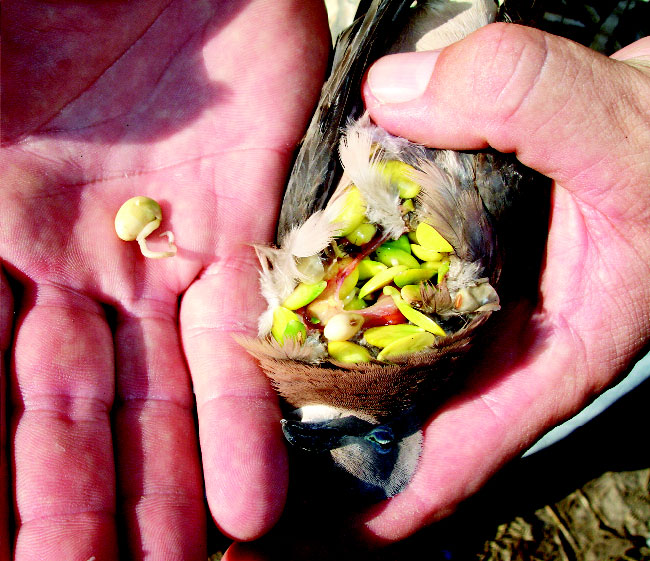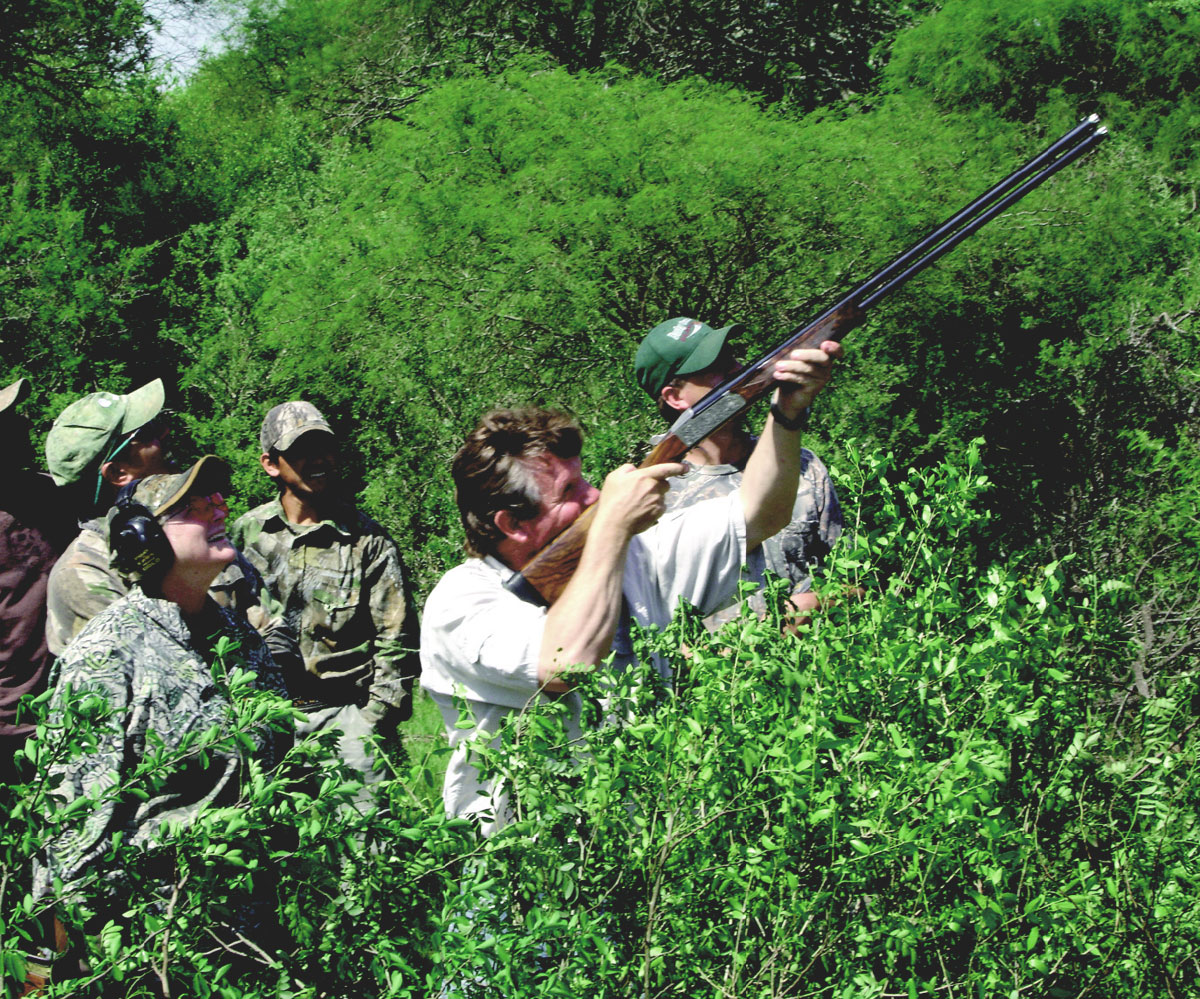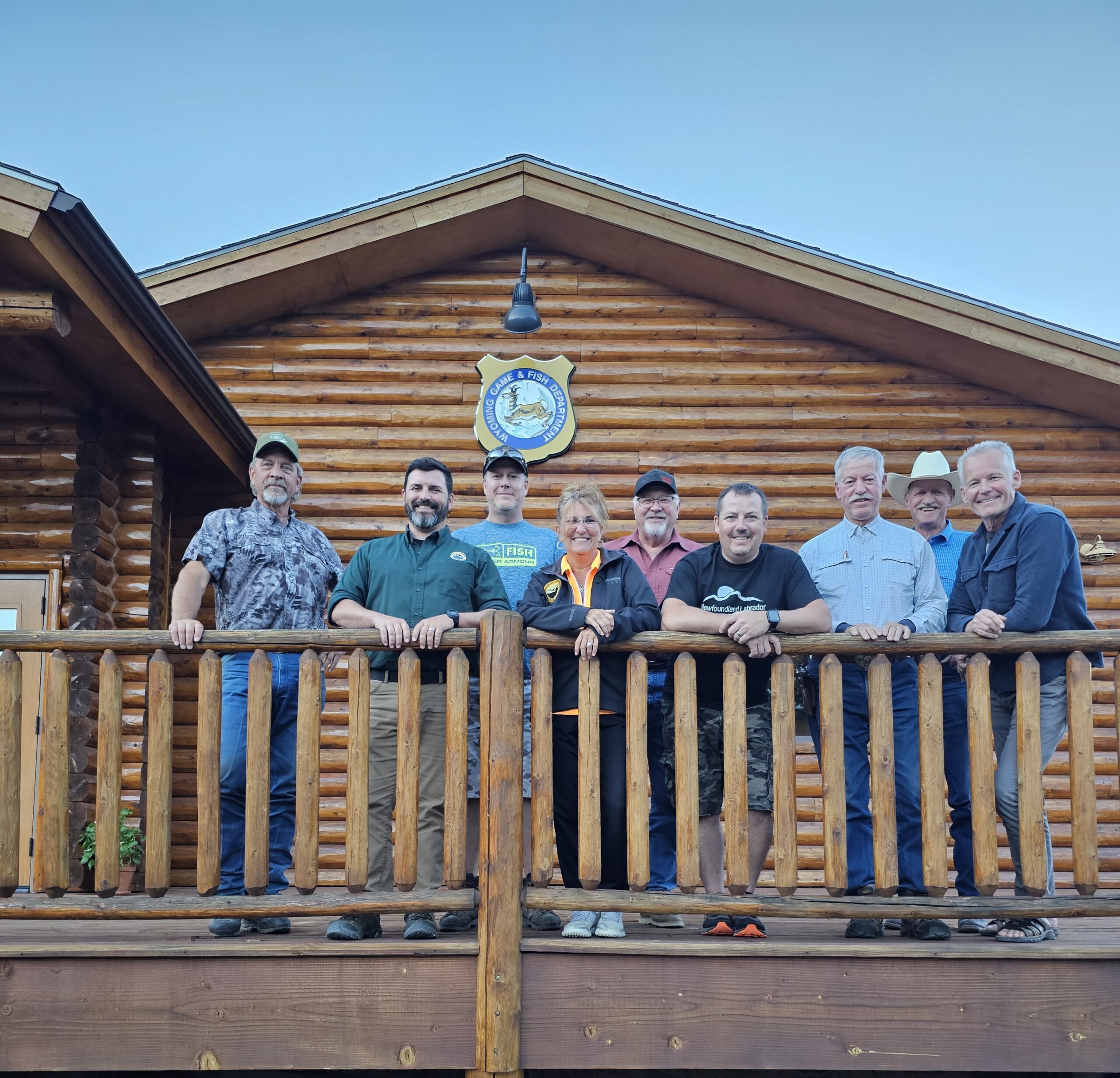Gil and Vicki Ash help a new shotgunner be a better shot by keeping both eyes open.
By Gil and Vicki Ash
 Upon arrival we were stunned at the well-groomed front yard. The grass was manicured and the trees were pruned to form a canopy-like setting completely surrounding Estancia Cortaderas. The Parana River was the northwestern boundary of the Estancia and was larger than one would expect.
Upon arrival we were stunned at the well-groomed front yard. The grass was manicured and the trees were pruned to form a canopy-like setting completely surrounding Estancia Cortaderas. The Parana River was the northwestern boundary of the Estancia and was larger than one would expect.
Paul met us with the excited smile of a new friend and a twinkle in his eye, which made us feel welcome immediately.
We were the only ones in the lodge and were shown the spa area, complete with shower, wet and dry sauna, message rooms and hot tub room all on the second floor.
First on the hunting list were pigeons. Tired from a day of travel to Buenos Aries, then change airports, then to Santa Fe and a ride with Omar for about an hour and a half to the lodge, we decided to not leave at 5:30 the next morning. We retired early, slept until 5:30 and started the day off slowly with coffee in the room. This put us a little late by most hunting standards. But the best shooting was going to be between 2:30 and 5 p.m., so Paul called it right.
The pigeon hunting was a blast and there were many lessons learned, especially for Gil. These birds are very large compared to the doves we normally shoot. They are hunted much like ducks, but not over water. Just a blind and decoys on the ground. No calling necessary.
One of the biggest takeaways for both of us was the fact that they appear to be moving fast, but actually are moving very slowly. It is easy to shoot in front of the birds. Why in front? It goes back to gun speed equaling bird speed, which is the basis for consistency in our system of shooting. Even though they are big birds they can put a move on a hunter who comes up too suddenly or too early.
We used our 20 gauge K-20s on this hunt and they performed flawlessly. With the Isis recoil systems there was little or no felt recoil. Omar who was our chief guide, made shot selection. We would be using #5 lead, which just happens to be my favorite shot size for large birds like the pigeon. With Modified over Modified chokes and those #5s, it was an unbeatable combination with clean kills even at 40 yards. We had many headshots as well as the usual misses behind because the gun stopped when we checked the lead or we mounted too fast and the accelerating muzzle caught our eye.
While at Estancia Cortaderas we had an occasion to take the General Manager, Paul James, and Hunting Guide and gunsmith, Omar Borghello, out on a dove hunt with us. Paul has shot rifles and done a little wingshooting, but was closing an eye and trying to aim.
The next morning we all went to a field near the lodge and began to shoot. They watched. When we pulled the trigger and the bird folded, they landed at our feet or just in front or just behind us.
Then it came their turn and Paul was first. Vicki put two shotgun shell boxes on the ground and showed Paul what he was supposed to see when shooting with two eyes and how it was different from shooting with only one eye. When he understood the difference she had him move on a few birds with an empty gun and then he loaded one shell and the next bird that passed he missed behind but he knew WHY! He immediately said he had looked down the gun while looking at the bird which made the gun come up on the bird and made the gun stop as he pulled the trigger. It was almost magical what happened on the next shot. As the trigger broke the bird folded and hit the ground dead.
Paul shot his first box of shells with two eyes for the first time. He killed 11/25 and on every shot he missed, he called the error correctly and CORRECTED THE MISS. His comment was that everything was moving in slow motion and he knew even before he pulled the trigger when he was going to hit the bird and not.
“In the beginning I was afraid of not being able to keep both eyes open. I got this habit from rifle shooting. Got over it easily as I was told not to look at the barrel but concentrate on the target and fine tune on the head,” he said. “I was surprised when I did this that I was able to keep both eyes open and when mounting the gun use short and gentle movements and you become very accurate.”
W ill Paul be a great shot with two eyes from now on? Maybe, maybe not. That will depend on how much he practices, not on how much he understands the procedure.
ill Paul be a great shot with two eyes from now on? Maybe, maybe not. That will depend on how much he practices, not on how much he understands the procedure.
Omar was fascinated with our guns and wanted to shoot to see what the recoil was like with the Isis recoil system. To his amazement, after the first shot, he said, “It’s like shooting a .410.” Well we couldn’t agree more. The combination of the K-20 with 32- inch barrels and the Isis recoil system is amazing in that the felt recoil is reduced dramatically. But because of the material it is made of, there is no change in the balance of the gun. In a hunting gun, balance and handling are everything. When you combine target gun handling with reduced recoil, you have just about the perfect high volume gun.
If we were going to set the record for most doves shot in a day we would go to 20 gauge gas guns and take the plug out to have three or four guns with two loaders so the guns could cool down a little in their rotation.
We must have made an impression on Omar and Paul because they both arranged to shoot with us in the afternoon. We worked with both Paul and Omar in the morning and they could not believe how their consistency improved. Runs of six to eight dead birds in a row were not uncommon.
On the afternoon hunt Gil decided to shoot long, high incoming shots so he put in two full chokes and went to work minimizing his move and shooting birds farther and farther out in front, with Omar and Paul looking over his shoulder. One of the birds Gil shot spilled some grain as he fell and hit the ground. Paul went out to pick it up to show Gil why these birds are seen as a pest in Argentina. As he picked the bird up, falling from its craw were “germinated soy beans” and on closer inspection we found several with the new root still intact. These birds have learned where in the field the seeds are planted and they scratch the ground with their feet until they expose the seed and then they eat it. Estimates of as much as 30 percent of the crop can be lost to doves between planting and germination.
Hard to believe that this little bird could be this destructive. But when you add to the equation the fact that there are as many as five hatches each year, you can begin to see why the dove is seen as a pest and the hunter is welcome. Capitalism baby, you gotta love it! We are looking forward to coming back to Estancia Cortaderas later this year to shoot a mixed bag of ducks, perdiz, pigeons and doves. Maybe even try some fishing.
[youtube https://www.youtube.com/watch?v=7h8nZPIVfIM]

